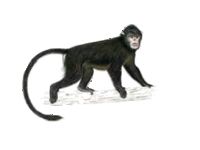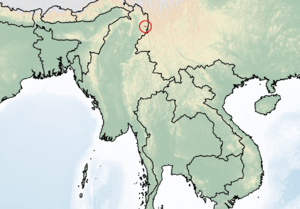Myanmar snub-nosed monkey facts for kids
Quick facts for kids Myanmar snub-nosed monkey |
|
|---|---|
 |
|
| Conservation status | |
| Scientific classification | |
| Genus: |
Rhinopithecus
|
| Species: |
strykeri
|
 |
|
The Myanmar snub-nosed monkey is a very rare type of monkey. It is also called the Burmese snub-nosed monkey or black snub-nosed monkey. Its scientific name is Rhinopithecus strykeri. Scientists first found this monkey in 2010 in northern Myanmar.
It was officially named a new kind of primate in 2011. Scientists looked closely at its unique fur, beard, and tail to identify it. Later, two more groups of these monkeys were found in China in 2011 and 2015.
Local people have special names for this monkey. In the Lisu language, it's called mey nwoah. In the Law Waw language, it's myuk na tok te. Both names mean "monkey with an upturned face". People say it sneezes when it rains because its nose points upwards. They also report that it sits with its head down, hiding its face between its knees during rain. This is why some people call it the "sneezing monkey"!
Contents
Discovery and Naming
How the Monkey Was Found
The Myanmar snub-nosed monkey was first found in 2010. This happened in the Gaoligong Mountains in northeastern Kachin state, Myanmar. A team of scientists was actually looking for another animal, the hoolock gibbon.
The team included Swiss primatologist Thomas Geissman and Ngwe Lwin from the Myanmar Biodiversity and Nature Conservation Association (BANCA). They got help from Fauna & Flora International (FFI) and the People Resources and Conservation Foundation (PRCF). They officially announced their discovery in a science journal in 2011.
What Makes It Special
The monkey has special features that help identify it. These include its unique fur, beard, and tail. The monkey's scientific name, strykeri, honors philanthropist Jon Stryker. He helped fund the project that led to the monkey's discovery.
First Samples and Sightings
The first monkey studied in detail was an adult male. Hunters in a place called Pade gave its skull and skin to the scientists. Scientists also collected other samples from animals killed earlier.
The team saw seven live monkeys, including a baby. But they moved away before the scientists could take photos. Later, more monkeys were found in China. In 2012, researchers used a camera trap to get the first known photos of these live monkeys.
Physical Appearance
What the Monkey Looks Like
This monkey's fur is mostly black. On its head, it has a thin, tall crest of long, black hair that curves forward. It has white, fluffy ear tufts that stick out. Its face is mostly bare with pale pink skin. It has a white "moustache" above its upper lip and a clear white beard on its chin.
The area around its bottom is white. Its arms and legs are mostly black. The inside of its upper arms and legs are brownish-black. Its lips are big, and its nose points upwards. This upturned nose is why people say it sneezes in the rain.
Size and Weight
Like other snub-nosed monkeys, males and females look different in size. This is called sexual dimorphism. Males are usually bigger than females. Their tails are also quite long, about 1.4 times their body length.
The first adult male found was about 55.5 centimeters (22 inches) tall. Its tail was 78 centimeters (31 inches) long. Males usually weigh around 17 kilograms (37 pounds). Females are about 53 centimeters (21 inches) tall. Their tails are about 64.5 centimeters (25 inches) long. Females weigh between 9 to 11.6 kilograms (20 to 26 pounds).
Where They Live and What They Eat
Monkey Homes and Habits
These monkeys spend their summers in cool, mixed forests high up in the mountains. In winter, they move to lower areas to avoid the snow. Unlike some other snub-nosed monkeys that spend time on the ground, the Myanmar snub-nosed monkeys mostly live in trees. They are very good at climbing! For every male monkey, there are about two females.
Their Home Range
When first found, these monkeys lived in only a few groups. Their home area was about 270 square kilometers (104 square miles). This was in the eastern Himalayas, in the northern part of Kachin State, Myanmar. They lived at heights between 1,700 to 3,200 meters (5,600 to 10,500 feet) above sea level.
In 2011, another group was found in China. This species is separated from other snub-nosed monkeys by the Mekong and Salween rivers. Other types of snub-nosed monkeys live in China and Vietnam. The Myanmar snub-nosed monkey shares its home with other monkeys like Shortridge's langur and different types of macaques.
In 2011, a forest guard in China took photos of a group of these monkeys. This was big news in China. It showed how important it was to protect them. Studies show that their habitat covers about 3,670 square kilometers (1,417 square miles) along the border of China and Myanmar.
What They Eat
These monkeys eat many different things. They can eat over 170 kinds of plants and fungi. They also enjoy eating about 15 types of lichens.
Protecting the Monkeys
Why They Are in Danger
The Myanmar snub-nosed monkey is in great danger. It is listed as Critically Endangered by the IUCN. This means they are at a very high risk of disappearing forever.
There are several reasons for this danger:
- Deforestation: Trees are being cut down for logging. This destroys the monkeys' homes.
- Isolation: The groups of monkeys are small and separated from each other.
- Hunting: Local people sometimes hunt them for food.
Scientists believe there are only about 260 to 330 of these monkeys left in Myanmar. In China, there might be fewer than 200.
Conservation Efforts
The Chinese population lives inside the Gaoligongshan National Nature Reserve. This is a protected area. In 2020, a new protected area was created in Myanmar. It's called Imawbum National Park. This park covers a huge area of high-elevation forests where these monkeys live. Organizations like Fauna and Flora International (FFI) and the Rainforest Trust helped make this park happen.
Origin and Evolution
Monkey Family Tree
Snub-nosed monkeys and langurs are two main groups of monkeys in Asia. Scientists have studied their DNA to understand how they are related. They found that all these Asian monkeys came from a single ancestor.
In 2012, scientists looked at the DNA of all ten types of odd-nosed monkeys. They found that the snub-nosed monkeys, like the Myanmar snub-nosed monkey, are the oldest group. This suggests that these monkeys first appeared in northern Myanmar. From there, they spread to other parts of Asia.
The snub-nosed monkeys separated from other Asian monkeys about 6 to 6.8 million years ago. Different species of snub-nosed monkeys split from each other more recently, about 400,000 to 730,000 years ago.
Recognition
A Top New Species
In 2012, experts at the International Institute for Species Exploration honored the Myanmar snub-nosed monkey. They named it one of the Top 10 New Species 2012. This list includes the most interesting new species found in 2011 around the world.
The monkey was chosen because of its unique look, its interesting behavior, and how vulnerable it is. It's not just new, but also very important for conservation. Its special "sneezing" behavior even earned it the nickname "the sneezing monkey."
See also
- Snub-nosed monkey
- Primates described in the 2000s
- List of endangered and protected species of China


